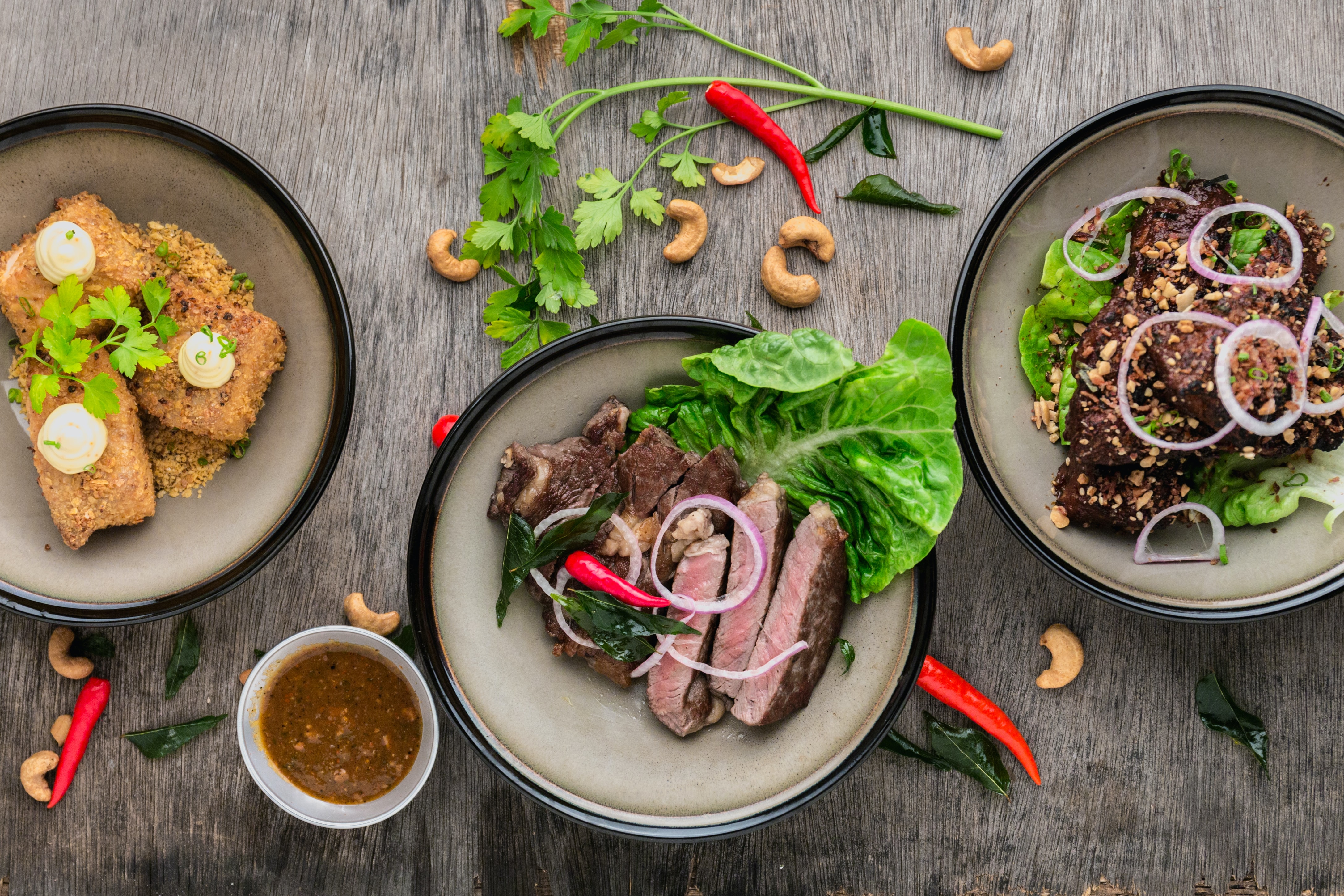Building muscle is one of the most popular fitness goals, and although we wish it was as simple as just eating more and lifting some weights, there’s actually more to it than that. When it comes down to it, you have to eat a lot!
As surprising as it might seem, there is a very sophisticated science behind putting on muscle, or ‘bulking’. It requires a delicate balance of nutrition and training to achieve the best results. And for many people just starting, this can feel overwhelming.
How do you balance your nutrition and your training, how much more should you eat, and what is a ‘dirty bulk’ versus a ‘lean bulk’? These are all questions that often get asked, and we are going to answer all of them and more in this article.
So if you’re someone who is looking to build muscle and want to learn everything about it, and the best ways to do it- read on!
Bulking Up to Build Muscle – How Do You Do it?
So you’re ready to bulk up, you’ve seen the photos and the articles and you understand the concept, but how do you actually do it?
Here’s a step-by-step guide to bulking up to build muscle.
- Calculate your daily calorie needs: The first step in bulking up is to determine how many calories you need to consume each day to create a calorie surplus. This means consuming more calories than you burn, which provides your body with the energy it needs to repair and rebuild muscle tissue. You can calculate your daily calorie needs using an online calculator or by working with a dietitian.
- Focus on protein: Protein is essential for muscle growth and repair, so it’s important to make sure you’re consuming enough of it. Aim to consume 1 gram of protein per pound of body weight each day and prioritize high-quality protein sources such as lean meats, poultry, fish, and dairy products.
- Incorporate complex carbohydrates: Complex carbohydrates, such as whole grains, fruits, and vegetables, provide energy and support recovery. Aim to consume a balanced mix of complex carbohydrates and healthy fats to fuel your workouts and support muscle growth.
- Strength train: Resistance training, or strength training, is an essential component of bulking up. This involves performing exercises that challenge the muscles and force them to grow. Your goal should be achieving muscular hypertrophy – which is when you work your muscles enough to tare the tissue, causing them to repair and grow.
- Allow for recovery: Finally, recovery is crucial for muscle growth. Make sure to give your body adequate rest and recovery time, and avoid overtraining. Sleep and stretching are also important for recovery, so make sure to get enough quality sleep each night and incorporate stretching into your routine. By following these steps and being consistent with your nutrition and training, you can effectively bulk up and build muscle. It’s important to remember that building muscle takes time, so be patient and stay committed to your goals.
Calorie Surplus – Why it’s Important

Source: Pexels
When it comes to building muscle, a calorie surplus is a key ingredient.
Basically, a calorie surplus means that you’re eating more calories than your body is burning. Doing this provides your body with the energy it needs to repair and rebuild muscle tissue.
When you strength train, you’re putting stress on your muscles, which can cause small tears in the muscle fibers. Your body will then repair and rebuild these tears, leading to an increase in muscle size and strength. The scientific term for this process is muscular hypertrophy.
Now, you want to make sure your body has the energy it needs to perform this repair and rebuild process, and that’s where a calorie surplus comes in. If you don’t have a calorie surplus, your body won’t have the energy it needs to build new muscle tissue.
But, how to attain that calorie surplus is where different methods come in.
Dirty Bulk
The term dirty bulk is often used in the fitness world to describe a bulk where someone is eating a large excess of calories and consuming a lot of food without worrying about whether it’s healthy or not.
People who engage in dirty bulking usually go for high-calorie foods such as junk food, fast food, and processed snacks, thinking that this is the quickest way to get to a calorie surplus.
But the reality is, eating a lot of unhealthy, nutrient-poor foods can do more harm than good. It increases the risk of health problems like heart disease, diabetes, and more.
Moreover, dirty bulking can also slow down the muscle-building process and decrease athletic performance. The body has a hard time processing and using all of the junk food that is being consumed.
While a calorie surplus is necessary to build muscle, it’s important to remember to eat a balanced diet with nutritious, whole foods that support your goals.
Dirty Bulk Diet
A dirty bulking diet often includes foods that are high in calories but lacking in essential nutrients. Some specific examples of a dirty bulk diet may include:
- Fast food burgers and fries: High in calories and unhealthy fats, fast food meals can provide a quick and easy way to increase calorie intake.
- Junk food snacks: Chips, candy, and other processed snacks are high in calories, and sugar, and easy to eat in large quantities.
- Sugary drinks: Sodas, energy drinks, and sports drinks.
- Processed foods: Pre-packaged meals, frozen dinners, and other processed foods.
Lean Bulk
Lean bulk, also referred to as a clean bulk, is a term used to describe a bulk that focuses on eating a balanced diet packed with nutritious, whole foods to help build muscle in a slower, more controlled manner.
Unlike a dirty bulk, which involves eating anything and everything to get more calories, lean bulking focuses on eating only in a slight calorie surplus to build muscle without adding too much body fat.
Typically, people who undergo a lean bulk diet are choosing healthier options and are looking to build muscle in a slow, deliberate way without gaining much excess weight.
Choosing healthier foods to bulk has the bonus of providing your body with the energy and nutrients it needs to build muscle and stay healthy, while also reducing the risk of health problems from eating too many unhealthy fats, added sugars, and processed foods.
Along with a balanced diet, lean bulking also involves doing strength training consistently to help build muscle and stay toned.
Lean Bulk Diet
A lean bulk diet typically includes a variety of nutritious, whole foods that provide the body with the energy and nutrients it needs to build muscle. Some specific examples of a lean bulk diet include:
- Lean protein sources: chicken, fish, tofu, eggs
- Healthy fats: nuts, seeds, avocado, olive oil, coconut oil
- Complex carbohydrates: brown rice, sweet potatoes, whole grains, fruits, and vegetables
- Fiber-rich foods: fruits, vegetables, whole grains, legumes
- Healthy snacks and meal replacements: Protein bars and smoothies
Bodybuilding Snacks
Snacks can play an important role in a bodybuilding diet, providing an extra boost of energy, calories, and nutrients which will support muscle building and recovery.
When choosing snacks as part of a bodybuilding diet, it’s important to focus on nutrient-dense options that provide the body with the energy and nutrients it needs to build muscle and support overall health. Even though eating snacks for muscle gain can be healthy and yield results, you still want to get the majority of calories from your main meals (usually 3 to 8 per day depending on your size and goals).
Some specific examples of some of the best bodybuilding snacks include:
- Greek yogurt with berries and nuts
- Hard-boiled eggs with whole-grain crackers
- Protein shake made with almond milk and a scoop of whey protein powder
- Cottage cheese with fruit and granola
How to Bulk Up for Skinny Guys

Source: Pexels
If you’re a skinny guy, you might feel like building muscle is an impossible task. Despite having a regular workout routine and eating healthy, you might still feel like you aren’t seeing any results.
Well, not to worry – not only is this a common feeling, but the truth is, it is a completely solvable issue. With the right approach, anyone can build muscle and achieve the results they want.
Think of building muscle like growing a garden.
Just as a garden needs fertile soil, adequate sunlight, water, and care to thrive, your muscles need the right combination of nutrients, exercise, and rest to grow.
It takes time and patience, but with consistency and attention to detail, you’ll see results.
There are a few extra things that skinny guys need to take into consideration for proper muscle building.
- Consume enough calories: This is typically where skinny guys struggle. A calorie surplus is essential to build muscle, but most skinny guys tend to under-consume. Once you know how many calories you need to maintain your current BMI (Body Mass Index), aim to consume at least 300-500 more calories per day to build muscle.
- Lift heavy weights: Focus on compound exercises that work multiple muscle groups, such as squats, deadlifts, and bench presses, and aim to increase the weight you’re lifting over time.
- Increase your protein intake: Protein is essential for muscle building and repair, so make sure you’re consuming enough each day. Aim to consume at least 1 gram of protein per pound of body weight each day.
- Don’t burn excess calories: Since it’s common for skinny guys to have high metabolism rates, they typically burn calories at a fast pace and this means they need to pay extra attention to how many calories they are burning.
- Workout Until Failure: Working out until failure means you are completing reps until you are no longer able to. This helps ensure you are achieving muscular hypertrophy. You don’t need to go until failure every set, but you should at least do this one set per exercise.
This means potentially avoiding things like extra cardio exercise during the week. If your goal is to bulk, then you want to put your extra calories towards building muscle rather than cardio exercise.
Do Calisthenics Build Muscle?
Calisthenics can be a great way to build muscle, but it all depends on how you approach it. You can’t just do a few push-ups and sit-ups every day and expect to see major gains in muscle mass.
If you want to try bulking with calisthenics, you need to challenge your muscles with high intensity and high volume exercises. Exercises like pull-ups, dips, and muscle-ups are a great way to build muscle with calisthenics.
Many people who want to bulk up while keeping their body lean and defined follow a lean bulk approach, and calisthenics fits right in with this strategy.
To take your calisthenics routine to the next level, you can incorporate weights and resistance bands to increase the intensity and promote muscle growth. If you’re still wondering about how to build muscle with calisthenics, the simple answer is: (1) Eat a lot, enough where you are in a calories surplus (2) perform your exercises until failure so you can achieve muscular hypertrophy.
Do Mass Gainers Work?
When it comes to building muscle, mass gainers are a popular option for many people.
The idea is simple – by consuming a high-calorie supplement, like gainer shakes, you’ll be able to consume more calories than you burn and promote muscle growth.
But is it really that simple? Well, it depends.
Mass gainers can be a useful tool for some people, but they’re not a one-size-fits-all solution. If you struggle to eat enough food to meet your calorie needs, a mass gainer can be a convenient way to add extra calories to your diet and support muscle growth.
However, it’s important to remember that mass gainers aren’t a substitute for a balanced diet that includes a variety of whole foods. Processing gainer shakes is tough on your liver, and it can also get quite expensive depending on the brand you buy.
Pre-workout Meal for Muscle Gain
Whether you eat before your workout or not is really preference. If you do choose to have a pre-workout meal, it’s best to do so about an hour before your workout. This gives your body enough time do digest the food so you don’t feel bloated and sluggish during your routine. It is also optimal to harness the energy being provided by the calories from the meal. The best type of pre-workout meal is a light one. We suggest some protein (chicken, fish, beef, pork, etc.), a vegetable (preferably green vegetables, and a light side of complex carbohydrates (whole wheat, wild rice, oats, etc.) Make sure to hydrate properly as well.
Building Muscle for Women
When you think of bulking up and gaining muscle, you probably imagine some big buff guy lifting heavy weights and stuffing their face with chicken and rice. However, lots of women aim to achieve muscle gains as well. Just because a woman wants to build muscle, doesn’t mean they have to look like an all-pro body builder. In fact, there is a common misconception that women shouldn’t lift heavy because they are going to look too “bulky.” This complete garbage.
First of all, women should of course be allowed to look however they want, without judgement. Second, just because somebody lifts heavy weights, it doesn’t mean they are going to automatically get huge. Lifting weights and eating to achieve a calorie surplus can help woman achieve very healthy muscles gains that add up to a well-toned physique.
Bulking for women should not be taboo, and in fact should be encouraged. Gaining muscle the right way helps prevent injuries and makes you stronger. A muscle building diet for women looks like the same exact thing as for men, it just all depends on body weight, preferences, and goals.
Bulking Tips
We have gone through the foundations of bulking and building muscle, so now we want to share some of our best tips to help you maximize your results.
- Focus on compound exercises: Compound exercises, such as squats, deadlifts, and bench presses, work multiple muscle groups at once, making them more efficient for building muscle.
- Vary your rep ranges: To effectively stimulate muscle growth, it’s important to vary your rep ranges. Aim to perform exercises with heavy weights for low reps, as well as lighter weights for high reps. This can help to shock your muscles and promote growth.
- Time your meals strategically: Eating more frequently throughout the day can help keep your metabolism elevated and support muscle growth. Try to consume a meal or snack every 3-4 hours, and aim to eat a pre-workout meal for muscle gain.
- Prioritize protein: Protein is essential for building muscle, so make sure to prioritize it in your diet. Aim to consume 1-1.5 grams of protein per pound of body weight each day.
- Go Until Failure: working out hard enough to actually tare your muscle tissues so they can rebuild themselves bigger is crucial.
Building Muscle After 50 Years Old
Building muscle after 50 can seem like a daunting task, but with the right approach and mindset, it is possible to achieve great results. Age should never be a barrier to physical progress, and with a little bit of creativity, you can build the physique you’ve always wanted.
It’s important to remember that as you age, your body naturally loses muscle mass, bone density, and most importantly, testosterone.
This is why it’s crucial to incorporate strength training into your routine, not just for aesthetic purposes, but for overall health and wellness. Resistance training can help slow down the aging process and prevent muscle loss, as well as improve bone health.
However, it’s also important to approach your workouts with caution. As you age, your body becomes more susceptible to injury, so it’s crucial to prioritize form, technique, and lighter weights over heavy weights.
Incorporating a variety of exercises, such as squats, lunges, and push-ups, will also help target multiple muscle groups and prevent boredom.
A healthy diet is just as important for building muscle as exercise. Consuming a balanced diet that includes plenty of protein, carbohydrates, and healthy fats will help provide your body with the nutrients it needs to build muscle and recover from workouts.
Building Muscle After 60 Years Old
Building muscle after the age of 60 can come with its own set of challenges, but with the proper knowledge and a well-planned-out program, it is totally possible.
While the basics of building muscle remain the same, there are some important differences to consider when building muscle over 60.
One of the biggest differences is the rate of muscle recovery. As we age, our muscles take longer to recover after a workout, meaning that it’s important to give them adequate rest and recovery time.
It’s also important to be mindful of avoiding overtraining, as this can further delay muscle recovery and increase the risk of injury.
Another difference is the role of nutrition. As we age, our nutritional needs change, and it’s important to ensure that you are consuming enough protein, vitamins, and minerals to support muscle growth.
You may also need to adjust your calorie intake to account for a slower metabolism.
Bulking Supplements

Source: Pexels
Now that you are getting started on your muscle-building journey, if you are looking to add some extra oomph, bulking supplements might just be the answer!
Keep in mind, though, that they’re just a supplement to your hard work, consistent diet, and dedicated training. They can’t replace the effort you put in, but they can give your body the extra push it needs to reach your goals.
When choosing bulking supplements, it’s important to go for products with proven ingredients and solid scientific backing. Bulk supplements creatine monohydrate, beta-alanine, and branched-chain amino acids (BCAAs) are some of the most popular choices for those looking to gain muscle mass.
Creatine is a natural molecule that has been shown to improve athletic performance, increase strength and support muscle growth. Beta-alanine helps to hold off fatigue during exercise, so you can push harder and build more muscle.
And BCAAs? They help prevent muscle breakdown and promote recovery, making them another top choice for anyone looking to bulk.
Conclusion
Building muscle is a delicate balance between nutrition and training.
A lean bulk, which involves eating in a slight calorie surplus with a focus on nutritious foods, is a more controlled and sustainable way to build muscle. A dirty bulk is focused on consuming excessive calories to put on weight fast.
Now that you know everything about bulking, you can follow these guidelines and you will be able to effectively bulk up and build muscle.
Zoppler is reader supported and may earn affiliate commissions from links on this page. We support and believe in all the products and services we promote and are affiliated with.











